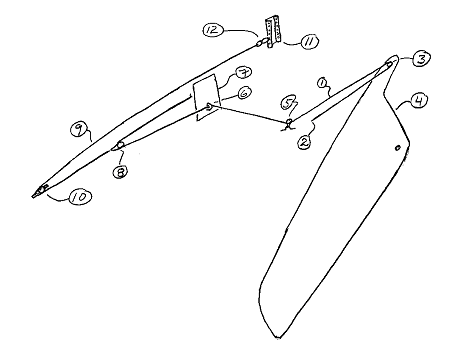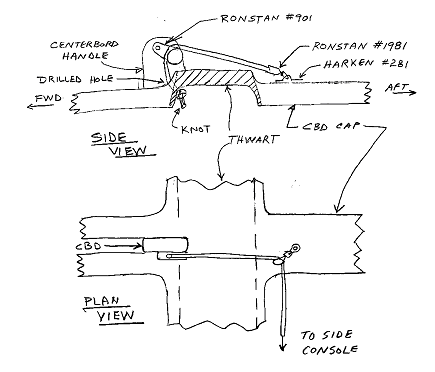By Barney Harris, USA 6701 & 8011
My first Albacore (7109) was equipped with a varnished mahogany centerboard which was held in place by a short length of line connected to the head and secured to a plastic clam cleat on the thwart. The cleated line had inadequate purchase to lower the centerboard, and the cleat held the board down even when it stuck the bottom – a frequent occurrence on the Potomac River. The line would frequently get caught in the main sheet. One time it was sucked out the bailer. The knot in the end of the line fouled in the bailer’s flapper valve and prevented lowering the board and closing the bailer – and resulted in a boat full of water. Finally, after only a couple encounters with the river bottom, the plastic cleat was reamed out and ceased to function. I removed the line and cleat and glued shims to my centerboard until there was enough friction between the board and trunk that it would remain in any position. This required that the crew manually position the board – and necessitated that they be in the middle of the boat while doing so. While this worked at first, the shims would wear out and the board would float up while planning or in response to the slightest encounter with the bottom. I thought there must be a better way.
The HAPCO centerboard downhaul and brake system was designed to overcome these shortcomings. It consists of a single piece of line 1 which is dead ended at the thwart 2, lead forward through a cheek block 3 on the centerboard 4, then aft to a swivel block 5 mounted just aft of the thwart on the centerboard cap. The line 1 is then lead to port through a fixed grommet 6 mounted low on the aft side of the port console 7. The line 1 is lead aft through the grommet 6 to a floating block, connected to shock cord 9, which is lead from the block 8 through a cheek block 10 installed under the side deck near the transom, and then forward to the port chain plate 11. Sister clips 12 enable the shock cord to be de-tensioned for storage.

Either a skipper or crew can grab the line 1 between the swivel block 5 and grommet 6 and lower the centerboard 4 from the port rail while rounding the leeward mark – and therefore leave the centerboard down longer.
Once lowered, the downhaul line 1 is cleaned up by the shock cord 9, so it never becomes fouled in the main sheet block, sucked out the bailer, or jammed into the centerboard slot.

Friction created between the line 1 and the solid grommet 6 serves to keep the centerboard 4 in the position set by the crew and resists the tendency to float up when going slow or to be swept aft at high speeds, yet is not so large that it prevents the crew from raising the board by simply pushing the handle forward.
